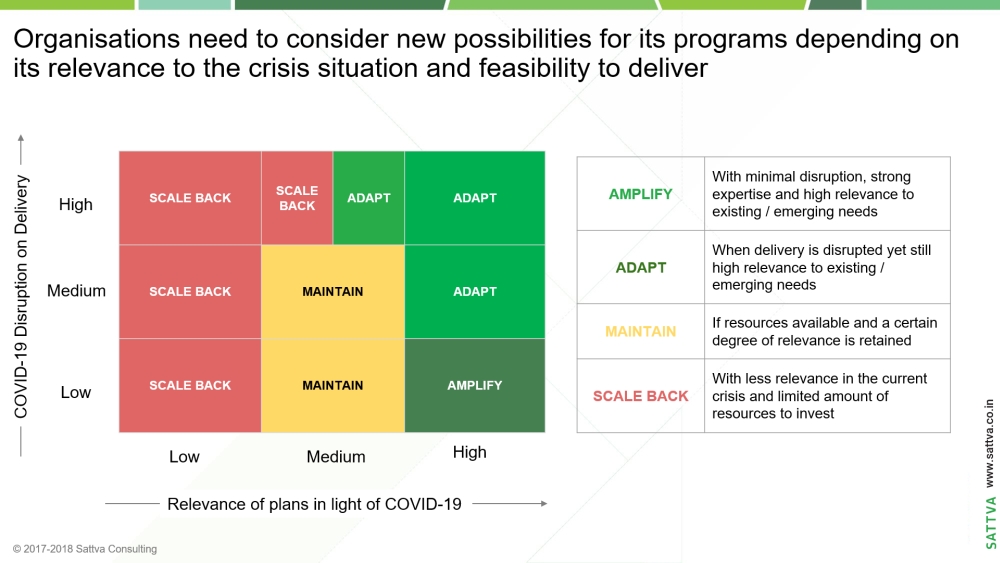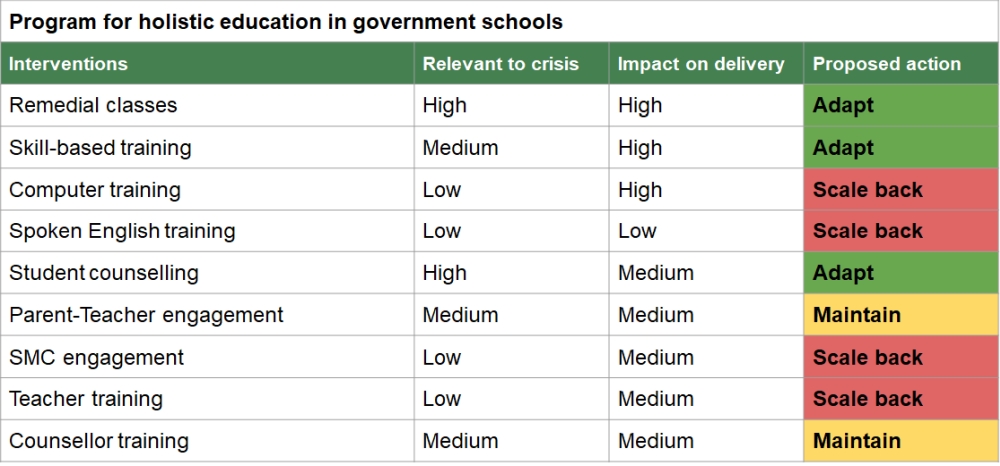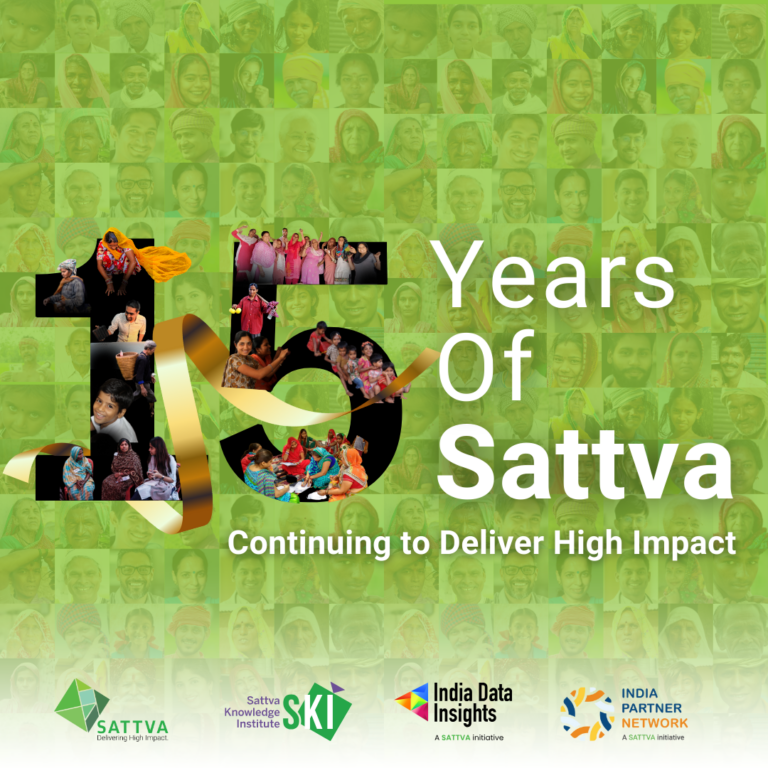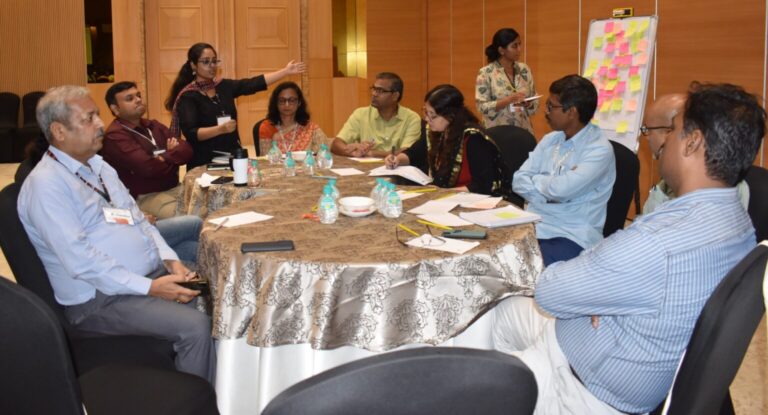How to Adapt and Pivot your Programmes
COVID-19 has caused a significant disruption in the social sector. With the country going in and out of lockdowns, field operations for most on-ground implementers can become sporadic and irregular. While nonprofit leaders act swiftly to mitigate the more immediate risks to financial sustainability and well-being of staff, they also need to think quickly on their feet and show the way forward to their organisation. Needs on the ground and the associated long-term solutions are continuing to evolve with many examples of nonprofits responding found through Sattva’s #agilityinadversity series. As leaders face these situations, it is only natural that they ask themselves some tough questions.
– Is our work and mission still relevant to the needs of our stakeholders?
– What are the current limitations that disrupt our delivery?
– What are the current focus areas that have become important?
– What are the emerging needs that our plans do not address?
Nonprofits need a plan to steer through the rough seas, bringing clarity and revisiting relevance in order to adapt and pivot their current programs. To do this, organisations should consider evaluating their ongoing programs along three parameters:
1. Disruption
Start with listing all limitations that currently impact the delivery of your program. Restricted mobility in the field, closing down of schools, non-availability of funds for initiatives, lack of technology integration to reach the last mile, etc. Creating a full list of such disruptions help you visualise the new playing field. As you do this, also list down the different solutions to these like leveraging technology, creating a cadre of on-ground community stakeholders, revisiting delivery models, etc.
2. Relevance
While all needs are relevant, it is important to critically assess this as every organisation has a fixed pie of resources and investments required to adapt. For example, a parent-focused early education service may be more relevant than before, while engagement with school SMCs may be less relevant. Assessing closely the relevance of program components will help you figure your priorities sharply.
3. Emerging needs
Lastly, organisations need to recognise any emerging needs on the ground. While your organisation is disrupted, so are the lives of the people you serve. It is, hence, important to keep an ear to the ground and understand the needs of your customer base, in the immediate term as well as in the mid-term and the long-term. The priorities and needs of people are continuously shifting in today’s environment, and so these needs can be moving targets. For example, the need for mental health support has increased significantly, so has the risk of gender-based violence. MSMEs need to quickly adopt COVID-19 safe service and digital payments. In some areas, practices like child marriage may be on the rise, and in others, school dropouts may be increasing. Whatever be your context, diving deep to learn the needs of your customers, across time horizons, is critical more than ever.
How to adapt your programmes?
To determine your response to each of your programs or interventions, look at their extent of the disruption and relevance on two axes. Those programs or interventions that have high relevance and low disruption during the pandemic need amplification, while others that are highly disrupted and less relevant now should be scaled back. Any disrupted programs or interventions that remain, roughly, as relevant as they were before COVID-19 should be the focus of adaptation. This may come in various mediums from changing delivery models to using digital technology to driving hyper-local delivery through a team of local volunteers. See Figure 1 for an overview of response themes.

Let’s look at an example of how to apply this framework to plan your adaptation. Here, we have considered an organisation that focuses on improving learning outcomes for children at government schools. The NGO offers a multitude of programs – from remedial support, mental health counseling, English and Computer training, parent engagement to skill based support. In the current crisis, reprioritising these offerings becomes critical to ensure efforts are focused in the right direction given fixed resources. Each program is mapped against the two parameters to help propose action based on resource limitation. This ensures that the core offering of the organisation and its focus on learning continues while the ancillary support areas are either maintained, scaled back or adapted to the current scenario.

How to pivot your interventions?
In order to act on unmet emerging needs of customers, organisations must pivot. In other words, they need to make the use of their existing or latent capabilities and freed-up resources in the best possible manner. There are five steps to achieving this:
1. Identify emerging needs – As covered above, the key here is to keep your ears to the ground and really understand your customers’ changing priorities across different time horizons. You can do this by conducting primary research with key relevant stakeholders via phone or video calls. Complement this with secondary research on trends in India and globally to understand needs on-the-ground in your relevant communities and at the ecosystem level.
2. Identify solutions – Next, think about how you can leverage your institutional expertise and capabilities to address any of these needs. This will need you to sort through adjacencies of your focus areas and delivery models. E.g. If you typically focus on capability building in Anganwadis, can your last-mile support parents in home-based learning, or support Anganwadi workers in continued immunisation.
3. Define a delivery model – While creating a pivot strategy needs innovative thinking, the execution needs a cautious thought. You have to ensure that your delivery is COVID-19 resilient and does not put any actor in harm’s way. More often than not, this will mean using existing technology wherever possible, e.g. using Whatsapp for sharing diagnostic information, or direct video consultation with front-line health workers. You may also tap into existing community assets in new ways, e.g. loudspeaker announcements from panchayats, which may have been rarely done earlier.
4. Design a pilot – Before taking any model to the ground broadly, it’s best to run a small pilot of an appropriate size. Designing your revised Theory of Change becomes critical here. Start with defining the impact you intend to create and the specific outcomes you would like to drive to achieve this impact. Then, work backwards from the outcomes. The outputs that each of your interventions drive must be aligned to one or more of these outcomes. Key is to keep these as easily measurable as possible.
5. Build measurable routines – Once the pilot finalised, define what data will you collect and at what intervals. Setting this routine will be important to identify weaknesses and make timely course corrections to ensure success of the program. Concurrent Monitoring & Evaluation systems will be important to continuously feed in learnings into program design for continuous strengthening.
Given the on-going disruptions, it is more important than ever to revisit the relevance of current programs, adapt to become COVID resilient and at times pivot to emerging needs on-the-ground. We are still in the earlier stages of the crisis, and it is important to reassess at the appropriate frequency as the landscape continues to evolve. Consciously optimising for impact given available funding and resources will help organisations remain mission-focused while navigating through the ever changing landscape.
Read more:
– Agility in Adversity – An ongoing series of stories on nonprofit organisations who have adapted or pivoted successfully
– How to ensure financial sustainability during COVID-19 – The first part of this article series on Sattva’s MAP framework
Do more:
– To learn more about Sattva’s MAP framework (mitigating institutional risks, adapting programmes, and pivoting to emerging needs on the ground), reach out to covid19response@sattva.co.in.
– Look at scenario planning for your non-profit at the link here.
This article is a part of a two part series on Sattva’s MAP (Mitigate-Adapt-Pivot) framework. You can read the first part on mitigating the challenge of financial sustainability here.
—————————-
Sattva has been working with various non-profits and social organisations as well as corporate clients to help them define their social impact goals. Our focus is to solve critical problems and find scalable solutions. We assist organisations in formulating their long-term social impact strategy by strategically aligning with business to provide meaningful solutions to social issues.
If you have any such stories or ideas to share, please write to us: impact@sattva.co.in



